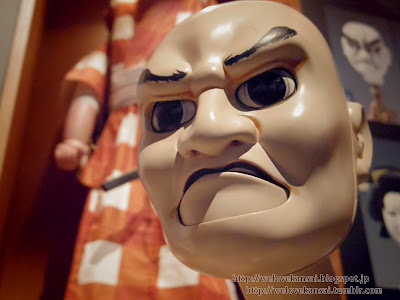
Puppet head from the Osaka Museum of History.
Access
Official Website Access Page
〒540-0008
大阪市中央区大手前4丁目1-32
(Osaka City, Chuou-ku, Otemae 4-chome 1-32)
TEL: 06-6946-5728
Hours of Operation: 9:30 - 17:00, Closed on Tuesdays
More Info Here
The train station closest to the museum is the subway's Tanimachi 4-chome Station on the Tanimachi Line. There will be signs in the subway with directions for the exit closest to the museum. The exit I took (Exit #2) lead me through part of the NHK building before I actually got to history building, while taking Exit #9 seems like a more direct route to the history building. From the first floor, you'll pay the entrance fee, then take an elevator to the top floor and work your way down.
Osaka Museum of History
Omotenashi Meter ★★★★★ out of 5⇒Entrance Fees (with tax)
Adults 600 yen Children 400 yen
 |
| A view from the Palace hall. |
The Osaka Museum of History is pretty easy to figure out. This museum focuses solely on the development and modernization of the area of Naniwa-kyo, that later came to be known as Osaka City.
 |
| A recreation of the Naniwa Palace. |
 |
| The staff at the museum were kind enough to snap this photo for me, hence the stoic face xD |
From this hall, you move into artifacts recovered from the discovery of Naniwa Palace, a small exhibit about the discoverer of these artifacts and some history on the Osaka before Naniwa Palace.
Moving down to the 9th floor, you start with the middle ages (roughly from the start of the Taira government, a samurai-based government system, until the Azuchi-Momoyama era of Japanese history) and travel through a sea of miniature models on to the Edo era.
 |
| This is the danjiri probably maybe. |
This area is full of video and audio presentations, but sadly, they aren't translated. Some of the plaques do feature a translation.
 |
| Osakan Indiana Jones welcomes you. |
On the 8th floor, you'll find the history excavation area. This area features many colorful explanations in Japanese about the process used to find many of the artifacts in the museum. You can also try your hand at putting together broken pieces of (plastic) pottery. It's obviously aimed toward kids (damn you tiny chairs), but I saw a lot of couples there having a good time too.
 |
| This was harder than it looks. |
 |
| View of the Shinsaibashi sign from the 8th floor. |
There are examples of trains, a telephone booth, a market, workshops and a house from this period, and they are fairly interactive though they ask that you not pick up food in the market.
 |
| Tickets from the World Expo in 1970 in Osaka. |
The other side of this floor displays a collection of items from the Showa period like tickets to the world expo in Osaka and kimono from that era.
Overall, this museum was great! The interactive exhibits, along with the video and audio, make it an ideal museum for children and really reminds of the National Museum of American History back in D.C. (I went there a lot as a kid lol). Of course, in the case of the Osaka Museum of History, it will definitely help if the kids can speak some Japanese, otherwise there will be a lot of explaining to do.
Also, this museum wasn't so crowded, for it being a Sunday and all, so there doesn't seem to be much a crowd issue. I didn't notice any signs banning selfie sticks, like with the Osaka Museum of Housing and Living, but flash photography is not allowed on all floors (except for one area) and tripods are not allowed.
Omotenashi Meter
5★ out of 5I think this is my first 5! This museum ranks so high probably because of the lack of people that day. It's one of the few places were you could take your time and read the signs in exhibits or just wander through at your own pace. The staff were very friendly and quick to offer information in many languages (they offered Shota a Chinese and Korean pamphlet). The exhibition route is easy to follow and the interactive exhibits are a major plus as many museums have a no touchy policy. The price was also very reasonable and it's one of the few places I'd take a friend to as well (as opposed to just telling them about it).
If you're a Japanese history nut, and especially a kansai/Osaka history nut, then you must pay a visit. You can event get a ticket for the castle and the museum together and save yourself a bit of money. ^o^)//
Further Reading
Learning things is awesome! If you wanna learn more, then check out some of the articles below! Drop a line if you'd like suggestions on other resources and I'll see what I can dig up. ;>Wikipedia Article on the Taira Clan
Japanese Wikipedia Article on Naniwa Palace
Wikipedia Article on the Azuchi-Momoyama Period
Japanese Wikipedia Article on Dai-Osaka
If you have any questions, comments or concerns, they're always welcome in the comments below or by e-mail!
★Peaces★





No comments: